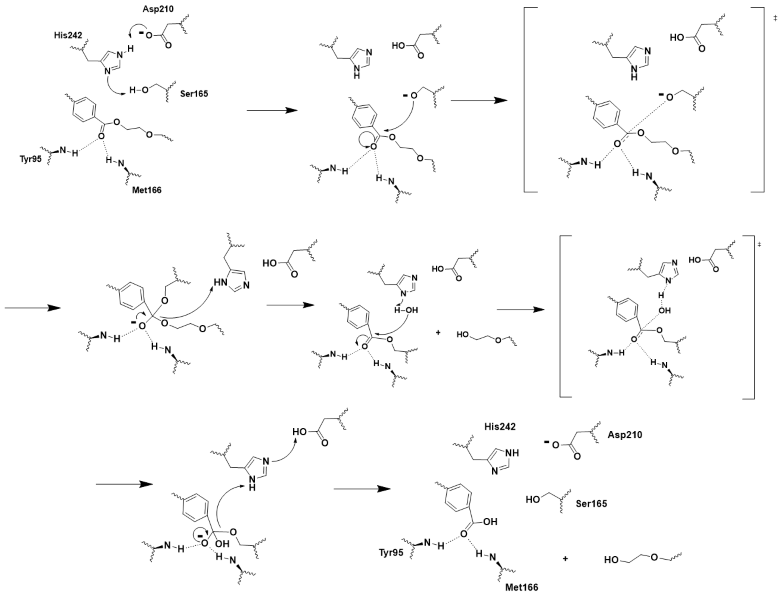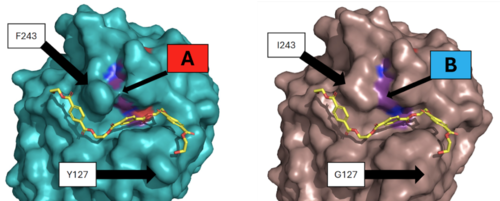User:Hayden Vissing/Sandbox 1
From Proteopedia
(Difference between revisions)
| Line 9: | Line 9: | ||
===Enzyme hydrolysis=== | ===Enzyme hydrolysis=== | ||
| - | One solution that researchers have been studying is using a naturally occurring enzyme that has PET degrading activity, PET hyrdolase, to break down the polymer into its monomers. This would allow the PET to be reformed from its monomers into a new piece of plastic. | + | One solution that researchers have been studying is using a naturally occurring enzyme that has PET degrading activity, PET hyrdolase, to break down the polymer into its monomers<ref>PMID:32269349</ref>. This would allow the PET to be reformed from its monomers into a new piece of plastic. |
A class of enzymes that has been a focus is [https://en.wikipedia.org/wiki/Cutinase Cutinase]. | A class of enzymes that has been a focus is [https://en.wikipedia.org/wiki/Cutinase Cutinase]. | ||
| Line 15: | Line 15: | ||
===Leaf-branch compost cutinase (LCC)=== | ===Leaf-branch compost cutinase (LCC)=== | ||
| - | The study done by Tournier et al. (2020) identified a good template enzyme for creating a PET hydrolase as the LCC enzyme. This enzyme was discovered through [https://en.wikipedia.org/wiki/Metagenomics metagenomics] of a leaf-branch compost. Its target substrate is the polymer [https://en.wikipedia.org/wiki/Cutin cutin], found in the cuticle of plants. LCC breaks down Cutin to separate the monomers at the ester bond between them. The LCC enzyme was compared to several other enzymes and was selected as it showed the best rate of PET depolymerization | + | The study done by Tournier et al. (2020)<ref>PMID:32269349</ref> identified a good template enzyme for creating a PET hydrolase as the LCC enzyme. This enzyme was discovered through [https://en.wikipedia.org/wiki/Metagenomics metagenomics] of a leaf-branch compost. Its target substrate is the polymer [https://en.wikipedia.org/wiki/Cutin cutin], found in the cuticle of plants. LCC breaks down Cutin to separate the monomers at the ester bond between them. The LCC enzyme was compared to several other enzymes and was selected as it showed the best rate of PET depolymerization |
==Mechanism== | ==Mechanism== | ||
===Overview of Active Site=== | ===Overview of Active Site=== | ||
| - | LCC is a serine hydrolase. The mechanism uses a <scene name='10/1076051/Wt_cat_triad/3'>catalytic triad</scene>: S165 (which was made into an alanine for crystallization purposes), D210, and H242. S165 is the nucleophile attacking the electrophilic carbonyl carbon with the <scene name='10/1075218/Oxyanion_hole/4'>oxyanion hole</scene> to stabilize the translation state. These key residues of the catalytic triad and oxyanion hole help to make up the <scene name='10/1076051/Wt_active_site/1'>active site</scene>. | + | LCC is a serine hydrolase. The mechanism uses a <scene name='10/1076051/Wt_cat_triad/3'>catalytic triad</scene>: S165 (which was made into an alanine for crystallization purposes), D210, and H242. S165 is the nucleophile attacking the electrophilic carbonyl carbon with the <scene name='10/1075218/Oxyanion_hole/4'>oxyanion hole</scene> to stabilize the translation state. These key residues of the catalytic triad and oxyanion hole help to make up the <scene name='10/1076051/Wt_active_site/1'>active site</scene><ref>PMID:32269349</ref>. |
[[Image:Push_mechanism.png|800px|center|thumb|Figure 2 - Push-mechanism for the cutinase reaction]] | [[Image:Push_mechanism.png|800px|center|thumb|Figure 2 - Push-mechanism for the cutinase reaction]] | ||
| Line 27: | Line 27: | ||
==Mutations== | ==Mutations== | ||
| - | After selection, LCC was mutated in order to improve its efficiency and thermal stability. Tournier et al. (2020) identified <scene name='10/1075218/Wildtype_residues/5'>11 residues</scene> from the wildtype as being apart of the <scene name='10/1076051/Contact_shell/1'>first contact shell</scene>. They then made hundreds of different mutation commutations, marking which altered efficiency and stability the most. Two of these 11 were chosen for the final mutant enzyme, <scene name='10/1075218/Identifiedresidues/12'>F243I and Y127G</scene>. These mutations were paired with two separately identified thermostability specific mutations (D238C and S283C) to make the final <scene name='10/1076051/Mutant_overview_shade/2'>ICCG</scene> enzyme. | + | After selection, LCC was mutated in order to improve its efficiency and thermal stability. Tournier et al. (2020)<ref>PMID:32269349</ref> identified <scene name='10/1075218/Wildtype_residues/5'>11 residues</scene> from the wildtype as being apart of the <scene name='10/1076051/Contact_shell/1'>first contact shell</scene>. They then made hundreds of different mutation commutations, marking which altered efficiency and stability the most. Two of these 11 were chosen for the final mutant enzyme, <scene name='10/1075218/Identifiedresidues/12'>F243I and Y127G</scene>. These mutations were paired with two separately identified thermostability specific mutations (D238C and S283C) to make the final <scene name='10/1076051/Mutant_overview_shade/2'>ICCG</scene> enzyme. |
===Efficiency improvement=== | ===Efficiency improvement=== | ||
[[Image:Thermo_pic.png|500px|right|thumb|Figure 3 - Protein surface images displaying the impact on the active site]] | [[Image:Thermo_pic.png|500px|right|thumb|Figure 3 - Protein surface images displaying the impact on the active site]] | ||
| - | Two of the mutations were selected as they showed the best improvement in catalytic efficiency. The mutation of residue 127 from a <scene name='10/1076051/Y127/2'>tyrosine</scene> to a <scene name='10/1075218/G127/6'>glycine</scene> and the mutation of residue 243 from a <scene name='10/1076051/F243/4'>phenylalanine</scene> to an <scene name='10/1075218/I243/3'>isoleucine</scene> improved the specific activity of the PET depolymerization of the enzyme by around 27%. This increase in catalytic activity was likely due to the decreased average distance between the catalytic residues in the mutant enzyme. This change can be seen in the surface view of the enzyme’s active site, which shows the loss of the “bridge” over the active site created by the interaction between F243 and its nearby residues. The loss of these interactions when changed to I243 most likely allows for the relaxation of the active site residues and the decrease in the distance between them. Molecular simulations showed that the distance between the carbonyl carbon of the substrate, oxygen of S165, and the nitrogen of H242 was decreased. | + | Two of the mutations were selected as they showed the best improvement in catalytic efficiency. The mutation of residue 127 from a <scene name='10/1076051/Y127/2'>tyrosine</scene> to a <scene name='10/1075218/G127/6'>glycine</scene> and the mutation of residue 243 from a <scene name='10/1076051/F243/4'>phenylalanine</scene> to an <scene name='10/1075218/I243/3'>isoleucine</scene> improved the specific activity of the PET depolymerization of the enzyme by around 27%<ref>PMID:32269349</ref>. This increase in catalytic activity was likely due to the decreased average distance between the catalytic residues in the mutant enzyme. This change can be seen in the surface view of the enzyme’s active site, which shows the loss of the “bridge” over the active site created by the interaction between F243 and its nearby residues. The loss of these interactions when changed to I243 most likely allows for the relaxation of the active site residues and the decrease in the distance between them. Molecular simulations showed that the distance between the carbonyl carbon of the substrate, oxygen of S165, and the nitrogen of H242 was decreased<ref>PMID:32269349</ref>. |
===Thermostability improvement=== | ===Thermostability improvement=== | ||
| - | To allow the enzyme to be effective in the recycling of PET, it needed to be stable in the high temperature environments used during the recycling process. Because of this, improvements needed to be made to the thermostability of the enzyme. The researchers went about this by searching for divalent metal binding sites, which had been seen to improve the thermal stability of other PET hydrolase enzymes. They found this site formed by the residues of E208, D238, and S283. These residues formed a similar structure that had been seen in other PET hydrolase enzymes, and when calcium ions were added to the enzyme the thermal stability improved. In order to avoid issues with purification, the team opted to avoid the addition of calcium salts and to instead create a disulfide bridge at the location of the divalent metal binding site. They chose to replace the <scene name='10/1076054/Thermostability_wild_type/3'>aspartic acid at 238 and the serine at 283</scene> with cysteine residues to form a <scene name='10/1076054/Iccg_disulfide_bridge/3'>disulfide bridge</scene>. This mutation improved the melting temperature of the enzyme by 9.8℃. | + | To allow the enzyme to be effective in the recycling of PET, it needed to be stable in the high temperature environments used during the recycling process. Because of this, improvements needed to be made to the thermostability of the enzyme. The researchers went about this by searching for divalent metal binding sites, which had been seen to improve the thermal stability of other PET hydrolase enzymes<ref>PMID:32269349</ref>. They found this site formed by the residues of E208, D238, and S283. These residues formed a similar structure that had been seen in other PET hydrolase enzymes, and when calcium ions were added to the enzyme the thermal stability improved. In order to avoid issues with purification, the team opted to avoid the addition of calcium salts and to instead create a disulfide bridge at the location of the divalent metal binding site. They chose to replace the <scene name='10/1076054/Thermostability_wild_type/3'>aspartic acid at 238 and the serine at 283</scene> with cysteine residues to form a <scene name='10/1076054/Iccg_disulfide_bridge/3'>disulfide bridge</scene>. This mutation improved the melting temperature of the enzyme by 9.8℃<ref>PMID:32269349</ref>. |
==Conlusions== | ==Conlusions== | ||
Revision as of 18:27, 22 April 2025
The Future of Recycling: the ICCG Mutant Pet Hydroalase
| |||||||||||
References
- ↑ Tournier V, Topham CM, Gilles A, David B, Folgoas C, Moya-Leclair E, Kamionka E, Desrousseaux ML, Texier H, Gavalda S, Cot M, Guemard E, Dalibey M, Nomme J, Cioci G, Barbe S, Chateau M, Andre I, Duquesne S, Marty A. An engineered PET depolymerase to break down and recycle plastic bottles. Nature. 2020 Apr;580(7802):216-219. doi: 10.1038/s41586-020-2149-4. Epub 2020 Apr, 8. PMID:32269349 doi:http://dx.doi.org/10.1038/s41586-020-2149-4
- ↑ Tournier V, Topham CM, Gilles A, David B, Folgoas C, Moya-Leclair E, Kamionka E, Desrousseaux ML, Texier H, Gavalda S, Cot M, Guemard E, Dalibey M, Nomme J, Cioci G, Barbe S, Chateau M, Andre I, Duquesne S, Marty A. An engineered PET depolymerase to break down and recycle plastic bottles. Nature. 2020 Apr;580(7802):216-219. doi: 10.1038/s41586-020-2149-4. Epub 2020 Apr, 8. PMID:32269349 doi:http://dx.doi.org/10.1038/s41586-020-2149-4
- ↑ Tournier V, Topham CM, Gilles A, David B, Folgoas C, Moya-Leclair E, Kamionka E, Desrousseaux ML, Texier H, Gavalda S, Cot M, Guemard E, Dalibey M, Nomme J, Cioci G, Barbe S, Chateau M, Andre I, Duquesne S, Marty A. An engineered PET depolymerase to break down and recycle plastic bottles. Nature. 2020 Apr;580(7802):216-219. doi: 10.1038/s41586-020-2149-4. Epub 2020 Apr, 8. PMID:32269349 doi:http://dx.doi.org/10.1038/s41586-020-2149-4
- ↑ Tournier V, Topham CM, Gilles A, David B, Folgoas C, Moya-Leclair E, Kamionka E, Desrousseaux ML, Texier H, Gavalda S, Cot M, Guemard E, Dalibey M, Nomme J, Cioci G, Barbe S, Chateau M, Andre I, Duquesne S, Marty A. An engineered PET depolymerase to break down and recycle plastic bottles. Nature. 2020 Apr;580(7802):216-219. doi: 10.1038/s41586-020-2149-4. Epub 2020 Apr, 8. PMID:32269349 doi:http://dx.doi.org/10.1038/s41586-020-2149-4
- ↑ Tournier V, Topham CM, Gilles A, David B, Folgoas C, Moya-Leclair E, Kamionka E, Desrousseaux ML, Texier H, Gavalda S, Cot M, Guemard E, Dalibey M, Nomme J, Cioci G, Barbe S, Chateau M, Andre I, Duquesne S, Marty A. An engineered PET depolymerase to break down and recycle plastic bottles. Nature. 2020 Apr;580(7802):216-219. doi: 10.1038/s41586-020-2149-4. Epub 2020 Apr, 8. PMID:32269349 doi:http://dx.doi.org/10.1038/s41586-020-2149-4
- ↑ Tournier V, Topham CM, Gilles A, David B, Folgoas C, Moya-Leclair E, Kamionka E, Desrousseaux ML, Texier H, Gavalda S, Cot M, Guemard E, Dalibey M, Nomme J, Cioci G, Barbe S, Chateau M, Andre I, Duquesne S, Marty A. An engineered PET depolymerase to break down and recycle plastic bottles. Nature. 2020 Apr;580(7802):216-219. doi: 10.1038/s41586-020-2149-4. Epub 2020 Apr, 8. PMID:32269349 doi:http://dx.doi.org/10.1038/s41586-020-2149-4
- ↑ Tournier V, Topham CM, Gilles A, David B, Folgoas C, Moya-Leclair E, Kamionka E, Desrousseaux ML, Texier H, Gavalda S, Cot M, Guemard E, Dalibey M, Nomme J, Cioci G, Barbe S, Chateau M, Andre I, Duquesne S, Marty A. An engineered PET depolymerase to break down and recycle plastic bottles. Nature. 2020 Apr;580(7802):216-219. doi: 10.1038/s41586-020-2149-4. Epub 2020 Apr, 8. PMID:32269349 doi:http://dx.doi.org/10.1038/s41586-020-2149-4
- ↑ Tournier V, Topham CM, Gilles A, David B, Folgoas C, Moya-Leclair E, Kamionka E, Desrousseaux ML, Texier H, Gavalda S, Cot M, Guemard E, Dalibey M, Nomme J, Cioci G, Barbe S, Chateau M, Andre I, Duquesne S, Marty A. An engineered PET depolymerase to break down and recycle plastic bottles. Nature. 2020 Apr;580(7802):216-219. doi: 10.1038/s41586-020-2149-4. Epub 2020 Apr, 8. PMID:32269349 doi:http://dx.doi.org/10.1038/s41586-020-2149-4
Student Contributors
- David Bogle
- Justin Chavez
- Hayden Vissing


